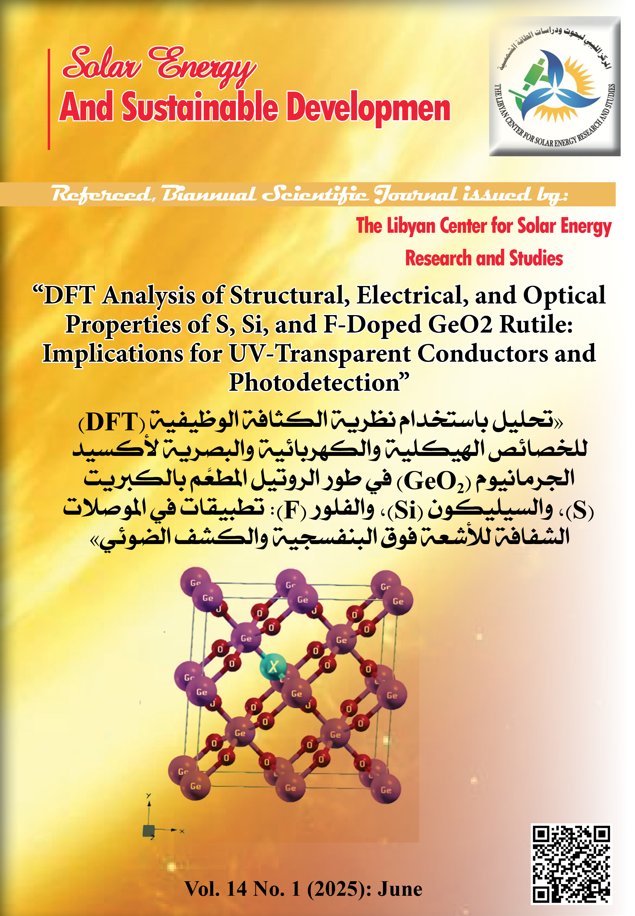DFT Analysis of Structural, Electrical, and Optical Properties of S, Si, and F-Doped GeO2 Rutile
Implications for UV-Transparent Conductors and Photodetection
DOI:
https://doi.org/10.51646/jsesd.v14i1.232Keywords:
GeO2 Rutile, doped GeO2, DFT, Semiconductor, Optical properties.Abstract
This study examines the structural, electrical, and optical properties of S-, Si-, and F-doped GeO2 rutile with a 6.25% doping concentration using density functional theory (DFT) and the FP-LAPW method. The results show that the structural parameters align with previous studies. Doping reduces the band gap from 4.09 eV for pure GeO2 to 1.98 eV for GeO1.9375Si0.0625. The optical properties, including dielectric constant, conductivity, refractive index, and absorption spectrum, were analyzed up to 13 eV, revealing anisotropy along the zz (001) and xx (100) axes. These doped materials are promising for UV-sensitive photonic detectors, as they remain efficient even under sunlight exposure in the visible and infrared spectra. This could lead to the development of photodetection devices suitable for bright environments where traditional detectors are affected by sunlight.
Downloads
Metrics
References
J.Y. Tsao, S. Chowdhury, M.A. Hollis, D. Jena, N.M. Johnson, K.A. Jones, and J.A. Simmons, “Ultrawide‐bandgap semiconductors: research opportunities and challenges”, Advanced Electronic Materials, vol. 4, no. 1, pp. 1600501, 2018. DOI: https://doi.org/10.1002/aelm.201600501
A. Walsh, J. Buckeridge, C.R.A. Catlow, A.J. Jackson, T.W. Keal, M. Miskufova, and A.A. Sokol, “Limits to doping of wide band gap semiconductors”, Chemistry of Materials, vol. 25, no. 15, pp. 2924-2926, 2013. DOI: https://doi.org/10.1021/cm402237s
Y. Yan and S.H. Wei, “Doping asymmetry in wide‐bandgap semiconductors: Origins and solutions”, physica status solidi (b), vol. 245, no. 4, pp. 641-652, 2008. DOI: https://doi.org/10.1002/pssb.200743334
W. Walukiewicz, “Intrinsic limitations to the doping of wide-gap semiconductors”, Physica B: Condensed Matter, vol. 302, pp. 123-134, 2001. DOI: https://doi.org/10.1016/S0921-4526(01)00417-3
S. Chae, J. Lee, K.A. Mengle, J.T. Heron, and E. Kioupakis, “Rutile GeO2: an ultrawide-band-gap semiconductor with ambipolar doping”, Applied Physics Letters, vol. 114, no. 10, 2019.
S. Chae, K.A. Mengle, K. Bushick, J. Lee, N. Sanders, Z. Deng, and E. Kioupakis, “Toward the predictive discovery of ambipolarly dopable ultra-wide-band-gap semiconductors: The case of rutile GeO2”, Applied Physics Letters, vol. 118, no. 26, 2021. DOI: https://doi.org/10.1063/5.0056674
K.A. Mengle, S. Chae, and E. Kioupakis, “Quasiparticle band structure and optical properties of rutile GeO2, an ultra-wide-band-gap semiconductor”, Journal of Applied Physics, vol. 126, no. 8, 2019. DOI: https://doi.org/10.1063/1.5111318
K. Bushick, K.A. Mengle, S. Chae, and E. Kioupakis, “Electron and hole mobility of rutile GeO2 from first principles: An ultrawide-bandgap semiconductor for power electronics”, Applied Physics Letters, vol. 117, no. 18, 2020. DOI: https://doi.org/10.1063/5.0033284
J.H. Sierra, D.O. Carvalho, L.R. Kassab, C.D. da Silva Bordon, R.E. Samad, N.U. Wetter, and M.I. Alayo, “Pedestal waveguides based on GeO2-Bi2O3, GeO2-PbO, Ta2O5 and SiOxNy cores as platforms for optical amplifiers, and nonlinear optics applications: Review of recent advances”, Journal of Luminescence, vol. 236, pp. 118113, 2021. DOI: https://doi.org/10.1016/j.jlumin.2021.118113
M. Peng, X. Meng, J. Qiu, Q. Zhao, and C. Zhu, “GeO2: Bi, M (M= Ga, B) glasses with super-wide infrared luminescence”, Chemical Physics Letters, vol. 403, no. 4-6, pp. 410-414, 2005. DOI: https://doi.org/10.1016/j.cplett.2005.01.054
M. Seal, N. Bose, and S. Mukherjee, “Application of GeO2 nanoparticle as electrically erasable memory and its photo catalytic behaviour”, Materials Research Express, vol. 5, no. 6, 065007, 2018. DOI: https://doi.org/10.1088/2053-1591/aac66b
S.O. Kucheyev, T.F. Baumann, Y.M. Wang, T. van Buuren, J.F. Poco, J.H. Satcher, and A.V. Hamza, “Monolithic, high surface area, three-dimensional GeO2 nanostructures”, Applied Physics Letters, vol. 88, no. 10, 2006. DOI: https://doi.org/10.1063/1.2182064
Y.H. Tang, Y.F. Zhang, N. Wang, I. Bello, C.S. Lee, and S.T. Lee, “Germanium dioxide whiskers synthesized by laser ablation”, Applied Physics Letters, vol. 74, no. 25, pp. 3824-3826, 1999. DOI: https://doi.org/10.1063/1.124192
H. Yin, W. Xiao, X. Mao, H. Zhu, and D. Wang, “Preparation of a porous nanostructured germanium from GeO2 via a “reduction–alloying–dealloying” approach”, Journal of Materials Chemistry A, vol. 3, no. 4, pp. 1427-1430, 2015. DOI: https://doi.org/10.1039/C4TA05244G
V.G. Hill and L.L. Chang, “Hydrothermal investigation of GeO2”, American Mineralogist: Journal of Earth and Planetary Materials, vol. 53, no. 9-10, pp. 1744-1748, 1968.
R. Pillarisetty, “Academic and industry research progress in germanium nanodevices”, Nature, vol. 479, no. 7373, pp. 324-328, 2011. DOI: https://doi.org/10.1038/nature10678
C. Claeys and E. Simoen, “Germanium-based technologies: from materials to devices”, Elsevier, 2011.
M. Sahnoun, C. Daul, R. Khenata, and H. Baltache, “Optical properties of germanium dioxide in the rutile structure”, The European Physical Journal B-Condensed Matter and Complex Systems, vol. 45, pp. 455-458, 2005. DOI: https://doi.org/10.1140/epjb/e2005-00219-y
M. Grimsditch, A. Polian, V. Brazhkin, and D. Balitskii, “Elastic constants of α-GeO2”, Journal of Applied Physics, vol. 83, no. 6, pp. 3018-3020, 1998. DOI: https://doi.org/10.1063/1.367117
B. Walker, C.C. Dharmawardhana, N. Dari, P. Rulis, and W.Y. Ching, “Electronic structure and optical properties of amorphous GeO2 in comparison to amorphous SiO2”, Journal of Non-Crystalline Solids, vol. 428, pp. 176-183, 2015. DOI: https://doi.org/10.1016/j.jnoncrysol.2015.08.018
M. Micoulaut, L. Cormier, and G.S. Henderson, “The structure of amorphous, crystalline and liquid GeO2”, Journal of Physics: Condensed Matter, vol. 18, no. 45, pp. R753, 2006. DOI: https://doi.org/10.1088/0953-8984/18/45/R01
T. Yamanaka, J. Mimaki, and T. Tsuchiya, “The bond character of rutile type SiO2, GeO2 and SnO2 investigated by molecular orbital calculation”, Zeitschrift für Kristallographie, vol. 215, no. 7, 2000. DOI: https://doi.org/10.1524/zkri.2000.215.7.419
L. Zhou and Z. Zhu, “Study of magneto-optical properties of GeO2-B2O3-P2O5-ZnO-Tb2O3 glass doped with different rare-earth ions”, Journal of Non-Crystalline Solids, vol. 576, 121241, 2022. DOI: https://doi.org/10.1016/j.jnoncrysol.2021.121241
H.O. Tekin, L.R.P. Kassab, S.A. Issa, C.D. da Silva Bordon, M.S. Al-Buriahi, F.D.O.P. Delboni, and E.S. Magalhaes, “Structural and physical characterization study on synthesized tellurite (TeO2) and germanate (GeO2), glass shields using XRD, Raman spectroscopy, FLUKA and PHITS”, Optical Materials, vol. 110, 110533, 2020. DOI: https://doi.org/10.1016/j.optmat.2020.110533
D. Marrocchelli, M. Salanne, and P.A. Madden, “High-pressure behaviour of GeO2: a simulation study”, Journal of Physics: Condensed Matter, vol. 22, no. 15, 152102, 2010. DOI: https://doi.org/10.1088/0953-8984/22/15/152102
G. Fraysse, A. Lignie, P. Hermet, P. Armand, D. Bourgogne, J. Haines, and P. Papet, “Vibrational origin of the thermal stability in the highly distorted α-quartz-type material GeO2: an experimental and theoretical study”, Inorganic Chemistry, vol. 52, no. 12, pp. 7271-7279, 2013. DOI: https://doi.org/10.1021/ic4009416
Q.J. Liu, Z.T. Liu, L.P. Feng, and H. Tian, “First-principles study of structural, elastic, electronic and optical properties of rutile GeO2 and α-quartz GeO2”, Solid State Sciences, vol. 12, no. 10, pp. 1748-1755, 2010.
E. Ghobadi and J.A. Capobianco, “Crystal properties of α-quartz type GeO2”, Physical Chemistry Chemical Physics, vol. 2, no. 24, pp. 5761-5763, 2000. DOI: https://doi.org/10.1039/b006839j
L. Giacomazzi and A. Pasquarello, “Vibrational spectra of vitreous SiO₂ and vitreous GeO₂ from first principles,” Journal of Physics: Condensed Matter, vol. 19, no. 41, pp. 415112, 2007. DOI: https://doi.org/10.1088/0953-8984/19/41/415112
M. Orio, D. A. Pantazis, and F. Neese, “Density functional theory,” Photosynthesis Research, vol. 102, pp. 443–453, 2009. DOI: https://doi.org/10.1007/s11120-009-9404-8
N. Argaman and G. Makov, “Density functional theory: An introduction,” American Journal of Physics, vol. 68, no. 1, pp. 69–79, 2000. DOI: https://doi.org/10.1119/1.19375
P. Blaha, K. Schwarz, G. K. Madsen, D. Kvasnicka, and J. Luitz, wien2k: An augmented plane wave + local orbitals program for calculating crystal properties, vol. 60, no. 1, 2001.
F. Tran and P. Blaha, “Accurate band gaps of semiconductors and insulators with a semilocal exchange-correlation potential,” Physical Review Letters, vol. 102, no. 22, pp. 226401, 2009. DOI: https://doi.org/10.1103/PhysRevLett.102.226401
J. Robertson, “Electronic structure of SnO₂, GeO₂, PbO₂, TeO₂, and MgF₂,” Journal of Physics C: Solid State Physics, vol. 12, no. 22, pp. 4767, 1979. DOI: https://doi.org/10.1088/0022-3719/12/22/018
H. Singh, M. Singh, S. Kumar, and M. K. Kashyap, “Full potential calculation of electronic properties of rutile RO₂ (R=Si, Ge, Sn, and Pb) compounds via modified Becke-Johnson potential,” Physica B: Condensed Matter, vol. 406, no. 20, pp. 3825–3830, 2011. DOI: https://doi.org/10.1016/j.physb.2011.07.004
M. Stapelbroek and B. D. Evans, “Exciton structure in the UV-absorption edge of tetragonal GeO₂,” Solid State Communications, vol. 25, no. 11, pp. 959–962, 1978. DOI: https://doi.org/10.1016/0038-1098(78)90311-3
D. M. Christie and J. R. Chelikowsky, “Electronic and structural properties of germania polymorphs,” Physical Review B, vol. 62, no. 22, pp. 14703–14711, 2000. DOI: https://doi.org/10.1103/PhysRevB.62.14703
C. Sevik and C. Bulutay, “Theoretical study of the insulating oxides and nitrides: SiO₂, GeO₂, Al₂O₃, Si₃N₄, and Ge₃N₄,” Journal of Materials Science, vol. 42, pp. 6555–6565, 2007. DOI: https://doi.org/10.1007/s10853-007-1526-9
Q.-J. Liu, Z.-T. Liu, L.-P. Feng, and H. Tian, “First-principles study of structural, elastic, electronic, and optical properties of rutile GeO₂ and α-quartz GeO₂,” Solid State Sciences, vol. 12, no. 10, pp. 1748–1755, 2010. DOI: https://doi.org/10.1016/j.solidstatesciences.2010.07.025
S. Chae, J. Lee, K. A. Mengle, J. T. Heron, and E. Kioupakis, “Rutile GeO₂: An ultrawide-band-gap semiconductor with ambipolar doping,” Applied Physics Letters, vol. 114, no. 10, pp. 102104, 2019. DOI: https://doi.org/10.1063/1.5088370
M. Feneberg, S. Osterburg, K. Lange, C. Lidig, B. Garke, R. Goldhahn, and al., “Band gap renormalization and Burstein-Moss effect in silicon-and germanium-doped wurtzite GaN up to 10²⁰ cm⁻³,” Physical Review B, vol. 90, no. 7, pp. 075203, 2014. DOI: https://doi.org/10.1103/PhysRevB.90.075203
P. V. Kamat, N. M. Dimitrijevic, and A. J. Nozik, “Dynamic Burstein-Moss shift in semiconductor colloids,” The Journal of Physical Chemistry, vol. 93, no. 8, pp. 2873–2875, 1989. DOI: https://doi.org/10.1021/j100345a003
Y. Ziat, A. Abbassi, A. Slassi, M. Hammi, A. A. Raiss, O. E. Rhazouani, and A. E. Kenz, “First-principles investigation of the electronic and optical properties of Al-doped FeS₂ pyrite for photovoltaic applications,” Optics and Quantum Electronics, vol. 48, no. 1, pp. 1–8, 2016. DOI: https://doi.org/10.1007/s11082-016-0781-x
Y. Ziat, Z. Zarhri, H. Belkhanchi, O. Ifguis, A. D. Cano, and C. Lazrak, “Effect of Be and P doping on the electron density, electrical and optoelectronic conduct of half-Heusler LiMgN within ab initio scheme,” Physica Scripta, vol. 97, no. 10, pp. 105802, 2022. DOI: https://doi.org/10.1088/1402-4896/ac8b40
Y. Ziat, Z. Zarhri, M. Hammi, H. Belkhanchi, O. Ifguis, A. D. Cano, and A. C. Bastos, “Effect of (Na, Si, Al, K or Ca) doping on the electronic structure and optoelectronic properties of half-Heusler LiMgN alloy: Ab initio framework,” Solid State Communications, vol. 343, pp. 114665, 2022. DOI: https://doi.org/10.1016/j.ssc.2022.114665
M. Radjai, A. Bouhemadou, and D. Maouche, “Structural, elastic, electronic, and optical properties of the half-Heusler ScPtSb and YPtSb compounds under pressure,” Condensed Matter Physics, vol. 24, no. 4, 2021. DOI: https://doi.org/10.5488/CMP.24.43702
S. Mubashir, M. K. Butt, M. Yaseen, J. Iqbal, M. Iqbal, A. Murtaza, and A. Laref, “Pressure induced electronic, optical, and thermoelectric properties of cubic BaZrO₃: A first principle calculation,” Optik, vol. 239, pp. 166694, 2021. DOI: https://doi.org/10.1016/j.ijleo.2021.166694
M. N. Islam and J. Podder, “Semiconductor to metallic transition in double halide perovskites Cs₂AgBiCl₆ through induced pressure: A DFT simulation for optoelectronic and photovoltaic applications,” Heliyon, vol. 8, no. 8, 2022. DOI: https://doi.org/10.1016/j.heliyon.2022.e10032

Downloads
Published
How to Cite
Issue
Section
License
Copyright (c) 2025 Solar Energy and Sustainable Development Journal

This work is licensed under a Creative Commons Attribution-NonCommercial 4.0 International License.













